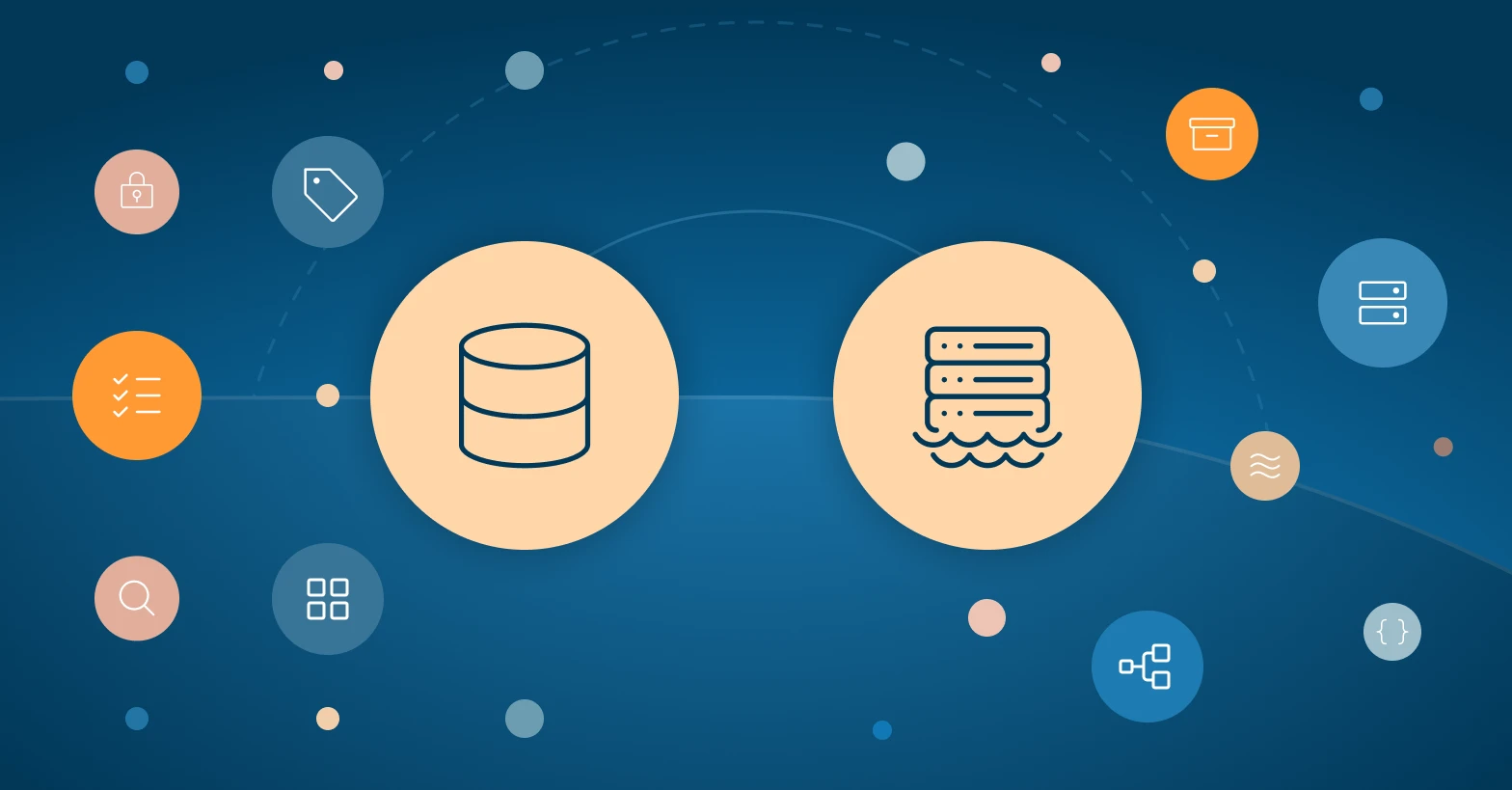The relationship between data lakes and data catalogs is a critical one; they often coexist within the same architecture but serve distinct purposes with different impacts on data management. They also sometimes get confused. So, let’s explore what each one is, how they’re different, and why a data lake is incomplete without a data catalog if you want to make your data assets more usable, discoverable, and secure.
Key architectural differences: How you store vs. use data
A data lake is a centralized repository used to store data in its native format, whether structured, semi-structured, or unstructured. It’s designed for scalable data storage, making it a go-to solution for storing big data, real-time data, and data from various data sources.
A data catalog, on the other hand, acts as a layer of metadata intelligence sitting on top of your data assets. It enables data discovery, data lineage tracking, integration, and governance. A catalog doesn’t store the data itself – it organizes it. It’s a kind of a map or a search engine for all the data within your organization.
Read more:
Data Catalog: Best Practices and Tips for Implementation and Maintenance
How to Build a Data Catalog: A Step-by-Step Guide
Evaluating Data Catalog Requirements – a Guide for Enterprise Teams
So, in a nutshell, a data lake gives you the infrastructure to store data, and a data catalog helps you actually use data effectively. Let’s break down the difference by core attributes:
| Feature | Data Lake | Data Catalog |
| Primary function | Store data in raw, scalable formats | Organize and tag metadata for search and discovery |
| Data type | Structured, semi-structured, unstructured | Metadata describing data in repositories |
| Users | Data engineers, data scientists, developers | Business users, analysts, data teams |
| Strength | Cost-effective data storage; stores large volume | Improves data discovery, usability, data governance |
| Architecture | Base layer in modern data architecture | Overlay that integrates with data lakes, data warehouses |
| Retrieval | Raw data access via query tools | Metadata-based query to locate assets and context |
Challenges of managing a data lake asset in your architecture
Despite their flexibility and scalability, data lakes come with inherent limitations, especially when it comes to organization, security, and data access.
The data swamp problem
The most notorious drawback of a data lake is its tendency to become a data swamp – a messy, time-consuming, and often unusable mass of raw information. (And we think it’s a pretty fitting metaphor.)
Without proper tagging, indexing, or metadata management, data lakes become difficult to query, manage, or derive insight from.
All of this is often because of:
- Lack of consistent metadata
- Poor lineage tracking
- No governance on naming conventions or data quality
In other words, a data lake without data governance is like a warehouse with no inventory list. You know the data is somewhere within the data, but finding it is a whole other story.
Security concerns
Security is another significant challenge. Data lakes typically store raw, often sensitive data assets in distributed file systems, which makes them prone to unauthorized access if not configured properly.
Common security concerns with data lakes include:
- No granular data access controls
- Lack of auditability and audit trails
- Vulnerability to internal misuse or data leaks
Unlike a data warehouse, which is usually tightly integrated with access roles and structured data processing, a data lake can become a high-risk zone without the right controls in place.
Why data lakes need data catalogs
To address the limitations we’ve listed above, many organizations layer a data catalog on top of their data lake. This way, an amorphous data dump is transformed into a structured, governed data management solution.
Here’s why the two should work together:
Improved data discovery and usability
A data catalog brings context to the raw data in your data lake. Users can search, filter, and understand datasets through metadata, tags, usage history, and lineage.
This helps to democratize data; with a user-friendly interface, even business users who are not particularly data-literate can perform basic queries without relying solely on technical teams.
Better data governance and auditability
Data catalogs support data governance policies through things like data classification, asset ownership assignments, and role-based access. They generate audit trails and enable visibility into who accessed what data and when.
This is especially important in regulated industries.
Integration across your data ecosystem
To put it very simply: Typically, in modern data architecture, data flows into the lake via ingestion pipelines. From there, a data catalog scans the lake for metadata and structures it into a searchable repository. It can also surface lineage and usage metrics, helping analysts understand how data is being transformed and queried across tools.
A good data catalog integrates with not just data lakes, but also data warehouses, analytics tools, and BI platforms. This creates a unified ecosystem where data from different sources and systems can be cataloged and accessed via a single source of truth.
What’s more, in enterprise environments, data lakes often span across regions, clouds, and technologies. A robust enterprise data catalog supports this kind of complexity, letting you integrate multiple sources into one searchable catalog.
Enhancing analytics and AI initiatives
AI and analytics teams need trusted, contextualized data. A data catalog makes it easier to locate relevant datasets, understand their origin and structure, and ensure data quality.
This significantly reduces time-to-insight and speeds up the data processing pipeline.
Read more: Machine learning data catalog
Streamlining data team collaboration
With modern data stacks (and traditional data systems, too), data engineers, analysts, and data scientists benefit from centralized metadata. It helps them avoid duplication, recognize existing data assets, and align on naming and architecture conventions.
These are the very basic data catalog benefits that take team collaboration to a whole new level of productivity.
Conclusion
Without a data catalog, data lakes risk becoming opaque, unmanageable repositories. But when you connect the two, they can become essential elements of a scalable, secure, and discoverable data environment, powering everything from real-time analytics to AI workloads.
If you’re investing in a data lake, or struggling to make the most of one, it might be time to look at the missing half of the equation. A well-integrated data catalog will make your data ecosystem usable, trackable, and ultimately, valuable.
(And we can help implement and/or integrate one – just give us a shout.)
FAQs
What is the difference between a data lake and a data catalog?
A data lake is a centralized storage system that holds large volumes of raw data in its native format, including structured, semi-structured, and unstructured data. A data catalog, on the other hand, is a metadata management tool that helps users find, understand, and govern that data by organizing it with searchable metadata, data lineage, tags, and more.
Can you use a data catalog without a data lake?
Yes, a data catalog can be used independently of a data lake. It can catalog data from a cloud data warehouse provider like Snowflake, object storage like Amazon S3, databases, and even SaaS platforms. It does become especially valuable when paired with a data lake, though, because it helps organize and manage the vast amounts of raw data stored there.
Do I need both a data lake and a data catalog?
In most data architectures, yes. A data lake offers scalable, flexible storage for all types of data, but it lacks structure and discoverability. A data catalog adds that missing layer of organization, enabling effective data access, discovery, governance, and analytics.
How does a data catalog improve data governance?
A data catalog supports data governance by making metadata and data lineage visible across the organization. It enables audit trails, access controls, and quality checks, helping use data within the organization responsibly and in compliance with regulatory standards.
Is a data lake the same as a data warehouse?
No. A data warehouse stores structured data optimized for reporting and analysis, often with a predefined schema. A data lake stores all types of data, including raw, unstructured, and semi-structured data, and is more flexible and scalable. Both can coexist in a modern data ecosystem, often with a data catalog helping to manage them together.
Share this article
Related Articles
See all-

15 November 2025
| Collibra experts for hireWhat is Collibra Edge? A 2025 Explainer
-

15 November 2025
| Collibra experts for hireThe definitive guide to Collibra Data Lineage
-

3 November 2025
| Collibra experts for hireCase Study: Discovering, classifying and cataloging unstructured data for a European bank



